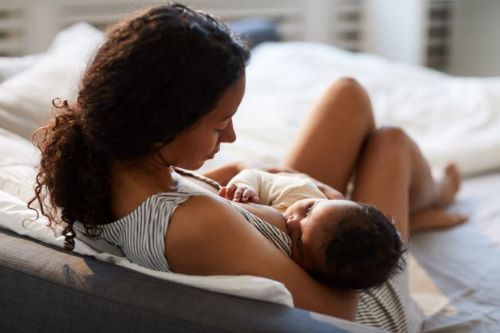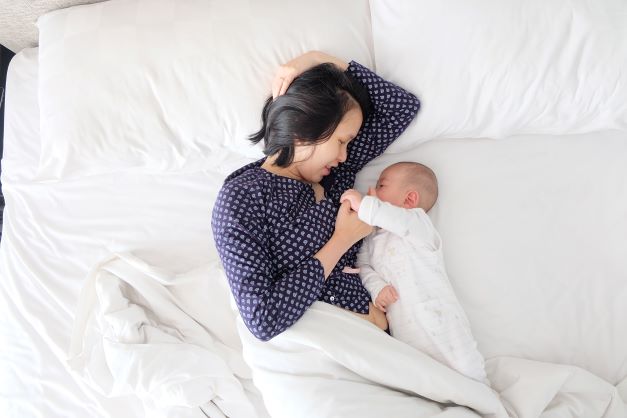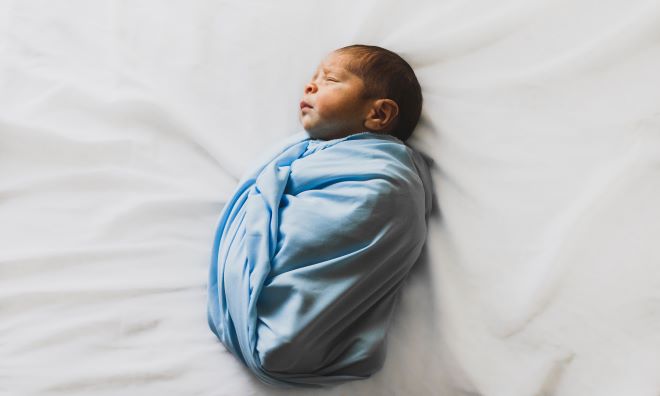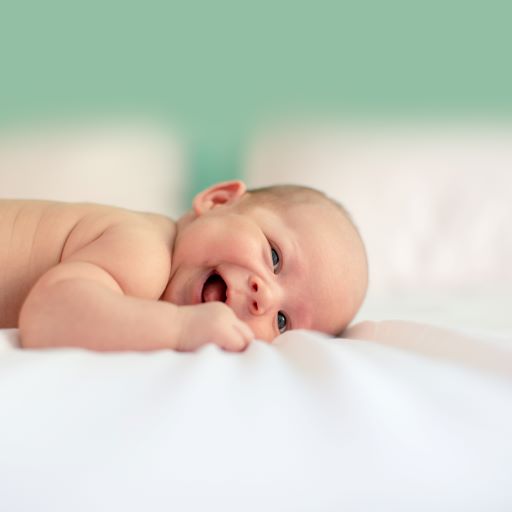First off, before getting into attachment theory and its influence, it’s important to define it. There’s been widespread confusion about the meaning of the term attachment theory since the introduction of the “attachment parenting” philosophy, but they’re two completely different things. “Attachment parenting” was coined by Doctors William and Martha Sears and refers to a specific parenting approach advocating things like baby-wearing, bed-sharing, and breastfeeding on demand.
The popularity of The Sears’ book appropriately caused some confusion about the differences between this parenting style and the scientific notion of attachment theory1. Because of the strong bias toward things like co-sleeping, nursing on demand and responding immediately to a fussing baby, you can understand how some parents would feel like they’re cutting heavy heart-strings with their sweet baby…as if removing these things as their babies learn to sleep on their own could damage the “attachment” between a baby and their caregiver. But again, neither of these attachment notions have anything to do with sleep training.

A developmental psychologist at the Institute for Child Development- University of Minnesota, defines attachment as “…a relationship in the service of a baby’s emotion regulations and exploration. It is the deep, abiding confidence a baby has in the availability and responsiveness of the caregiver.”2 This quote is valuable to me because, truly, it’s the baby’s decision on who they ‘attach’ to. Not giving the child the chance to figure things out on their own, when challenged, limits the baby’s capability to reach it’s full potential…
Anyway, after originating in Britain, attachment and it’s meaning expanded further West and became a fascination for American psychologist Mary Ainsworth. In its current understanding there are four categories of attachment between a baby and their caregivers: secure, insecure-avoidant, insecure- resistant, and insecure-disorganized.
Children with a secure attachment to their primary caregiver feel safe expressing distress or discomfort, and will explore unfamiliar areas around them confidently just as long as the caregiver is nearby. They often become distressed when their caregiver leaves their space, but bounce right back when they return.
Children with insecure attachments avoid their caregiver when upset and hold back displaying their true feelings in their presence (presumably because the caregiver has responded to past displays of distress and negative emotion in negative ways. ex, ignoring, ridiculing, or becoming visibly annoyed with the child.) The infant learns quickly that showing their negative emotions and feelings provoke negative emotions from their caregiver; leading the child to avoid displays of distress altogether.

A Minnesota Longitudinal Study of Risk and Adaptation over a 35-year period found that infants who fit the “secure attachment” criteria were more independent later in life, had higher self-esteem, better relationships with their family, and displayed greater coping, social and leadership skills than infants in the other three categories.3 I’m not meaning to say this is most important aspect of a child-parent relationship but it’s obvious how big of a role it does play!
A. Schore, a developmental neuroscientist in the Department of Psychiatry at UCLA defines attachment theory as, “essentially a theory of regulation.” He said “Insecure attachments aren’t created just by a caregiver’s inattention or missteps; they also come from a failure to repair ruptures. Maybe the caregiver is coming in too fast and needs to back off, or maybe the caregiver hasn’t responded and needs to show the baby that she’s there. Either way, repair is possible, and it works. Stress is a part of life, and what we’re trying to do here is to set up a system by which the baby can learn how to cope with stress.”
From this perspective, you could easily argue that the Sears method of responding immediately to a baby’s cries and always keeping them nearby could actually be detrimental to their development. Of course, if attachment parenting is the approach parents feel most comfortable with, it’s absolutely their right to practice it. But like any other parenting style, it has its potential disadvantages if adhered to too stringently without taking the individual baby’s needs and comfort into account.
It’s also pretty easy to see how parents could view the traditional cry-it-out approach as potentially damaging to the attachment they share with their babe. However, I want to reassure you that I will never ask you to leave your baby for prolonged periods of time without offering support and comfort. If I was advocating leaving your child to cry regardless of the length of time or severity, it would hardly be a service worth paying for.

I completely understand and respect your concern for your baby’s well-being, and I can tell you that the approach we’ll be taking with your little one will allow to you stay close to them, offer comfort, reassure them of your presence, and respond to their needs while they gradually learn to fall asleep independently. I encourage you to remain present and responsive throughout the process, and will never ask you to do anything that would damage your relationship with your baby.
That’s not to say that there won’t be any crying involved. There most likely will be, and I understand how difficult it can be to hear your baby cry, even for little bits of time, and even if you’re right there offering support. When our babies cry, our natural instinct as parents is to prevent it as quickly and effectively as we’re able.
This impulse to stop a baby’s crying can prompt parents to utilize whatever method of distraction or soothing has proven most effective; like nursing, rocking, or offering a pacifier, and while that might stop baby from crying, it likely hasn’t addressed the issue that caused baby to start crying in the first place.


As Magda Gerber, a noted child expert said, “An anxious and irritated parent will most likely do what brings the fastest relief – give the breast or bottle. The baby almost always accepts it, calms down and often falls asleep. Of course, this is the right solution if the baby is hungry. However, if the baby has other needs (for instance being tired or having pain), she will learn to expect food in response to these other needs, and grasp the breast or bottle even though she is not hungry.”
So if and when baby cries, I absolutely encourage you to respond. Check to make sure they’re fed and warm and that all of their basic needs are met. Watch to see if you can find any other source of discomfort or a pressing need. If you feel confident that baby’s only reason for crying is that they’re just not asleep yet, then you’re well on your way to solving this issue by helping them to learn how to fall asleep independently.
Your baby’s attachment to you doesn’t rely on being next to them at all times, or rushing to their side every time they feel frustrated or challenged. It is a product of consistent, reliable parenting, loving reassurance, and confidence that you will keep them safe, secure, and protected. Opportunities to assure, comfort, and encourage your baby will always present themselves, several times every day. When everyone in the family is well-rested, we’re more patient, more engaged, and better able to provide the love and support that are truly the foundation of a secure attachment with our children.
In short, the only change you’ll see is how well your baby sleeps.

- https://www.ncbi.nlm.nih.gov/pmc/articles/PMC2724160/
- https://www.developmentalscience.com/blog/2017/3/31/what-is-a-secure-attachmentand-why-doesnt-attachment-parenting-get-you-there
- https://www.ncbi.nlm.nih.gov/pmc/articles/PMC2857405/
- https://www.ncbi.nlm.nih.gov/pmc/articles/PMC2724160/https://www.ncbi.nlm.nih.gov/pmc/articles/PMC2724160/
What does secure attachment typically look like?
0-3 months:
- In their quiet, alert state, the baby is interested in the faces and voices around them.
4-8 months:
- Attempts to soothe the baby usually work. (Caveat: An inability to soothe might indicate either insecurity or any of a host of other possible issues.)
- The baby and primary caregiver have pleasant back-and-forth interactions.
- The baby has calm periods of curiosity and explores and experiments as they are physically able.
- The baby begins to discriminate among people and show preferences.
9 months:
- The baby shows a clear preference for a primary caregiver and some wariness toward strangers.
- The baby is easily upset when separated from their primary caregiver.
- The baby is easily soothed after a separation and can resume exploration or play.
9 months–3 years:
- The child shows a clear emotional bond with a primary person.
- The child stays in close proximity to that person but forms close relationships with other people, too.